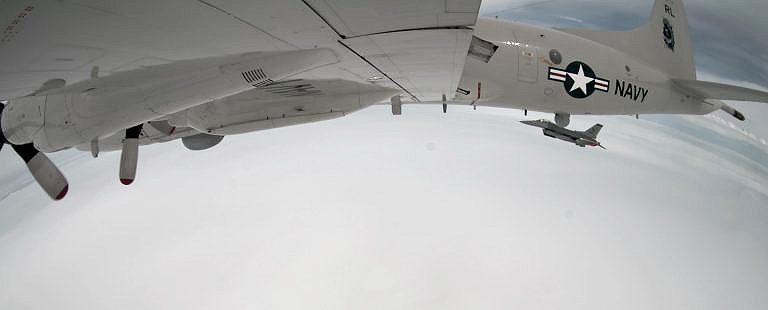Reports of “unsafe” intercepts have become headline staples over the past couple years. The reawakening of the Russian Bear and a more territorial China has led to a drastic increase in reckless aerial intercepts. They often include the intercepting fighter flying ridiculously close the “visiting” aircraft, or even doing acrobatics over and around it. They bring a real danger to the safety of the aircrews, and a mishap could spark an international incident (see the Hainan Island Incident) and a rapid military escalation.
After these intercepts, one side—almost always the US or its allies—file a formal diplomatic protest, and headlines are made. Often, a still image of a menacing-looking Su-27, or other fighter, displaying a belly bristling with missiles is distributed. Yet even this is rare, the picture often stock. The Pentagon, which has been very quick to post video of provocative military acts, is now working to catch these unsafe intercepts on camera and in spectacular fashion.
The Naval Research Laboratory has built a pod to do just that. Dubbed the Common Airborne Situational Awareness (CASA) pod, the unit is made up of the housing of a ALQ-167 electronic warfare training pod that has been adapted with apertures for multiple wide-angle HD video and still cameras and the ability to record and transmit the imagery collected by these cameras in real-time.
The idea is that this new pod can record an unsafe intercept in great detail from every angle, and that the footage recorded from it will likely be used for public release as well as intelligence gathering purposes.
Breakingdefense.com reports that the pod came to be under a Urgent Operational Needs requirement from the Navy’s Pacific Command. It seems like PACOM’s crystal ball was especially clear when it came to ordering this pod and getting it ready for deployment in quick order, as just last week a Navy EP-3E Aries II spy plane, one of America’s most sensitive intelligence gathering assets, was intercepted off of Hainan Island in a very aggressive manner. A pair of J-11 Flanker derivatives came within 50 feet of the lumbering EP-3E during the incident.
Considering the EP-3E’s wingspan is just shy of 100 feet, and the J-11’s is just shy of 50 feet, flying less than 50 feet of the EP-3E is too close for comfort. Almost making a case for the pod themselves, China has denied the details of the event put forward by the US Navy, with officials stating that the jets “kept a safe distance throughout, without taking any dangerous actions.”
This incident came following escalating tensions in the South China Sea, with China launching fighters from its new island outpost at Fiery Cross Reef against a US destroyer for the first time. China also denied the US supercarrier USS John C. Stennis a port visit to Hong Kong.
Still, the aggressive intercept is a bad sign when it comes to US-Chinese military tensions in the region. Just last September, during China’s president Xi Jinping’s state visit to the Washington DC, clear rules and procedures were supposedly hammered out and agreed upon by both countries to make sure intercepts like the one described above don’t happen. Now it appears that this rule book is being thrown out the door.

The CASA pod has already been successfully tested using a P-3 as a surrogate and a Air National Guard F-16 as an interceptor and could be deployed to the fleet at any time.
As a side note, this pod seems to open up a whole new realm of possibilities when it comes to military aviation video. The ALQ-167 can fly at high-speed on fighter jets, and it is a regular fixture on the Navy’s adversary support aircraft, such as VFC-12’s F/A-18s and contracted ATAC F-21 Kfirs and Phoenix Air Learjets. Even NSAWCs F-16s have been seen toting these electronic warfare pods as of late.
With this in mind, strapping one of these to a Navy fighter during low-level training flights, basic fighter maneuvers (BFM aka dogfights) or bombing and strafing runs would bring Hollywood-quality aerial footage from perspectives we have never seen before. So let’s hope eventually the Navy sends one of these things around the fast-jet fleet, its footage could be one hell of a recruiting tool.
In the meantime, unless Russia and China are on their best behavior, expect to see some incredible, if not somewhat terrifying real-world footage of what life can be like along the front lines of America’s aerial surveillance apparatus.
Contact the author at tyler@thedrive.com
